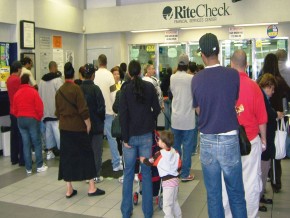For those who don’t have time to trek to banks, or the minimum account balance to always keep in reserve (essentially on long term loan to the bank) or the requisite paperwork, check cashers are the go to place for financial services.

The
New York Times features a story on New York City check cashing chain RiteCheck and its plans to offer a new savings program developed by IPA. Now when RiteCheck customers cash a check, they can instantly deposit a few dollars – or more – into a credit union savings account. Giving check cashing customers a safe place to save is only part of the innovation here. Catching customers at the moment they cash their checks, when they have the most liquidity, is a great way to encourage saving and remind customers of their savings goals at a critical moment when they can do something about it.
Behavioral economists know that one of the most important factor for encouraging a behavior is to
make it easy. As the Squared Away Blog
pointed out when the program was starting, the philosophy behind bringing savings to the people, where they are when they have money, is to make saving as easy as possible.
Key to making the program work is simplicity, operating on the theory that barriers and red tape thwart savings deposit; if a customer wants to open a savings account, RiteCheck will print an application that’s already filled out and needs only a signature. RiteCheck teamed up with long-time business partner Bethex Federal Credit Union to open and manage the accounts.
Squared away calls the approach “Impulse Savings” – people who don’t use traditional banks will still take advantage of the opportunity to save when given the chance. As The Times described one customer:
Phil Robinson, a butcher, said he could see himself putting away $10 every Monday when he cashed his paycheck at RiteCheck. He already allows himself $10 in lottery tickets. “I wouldn’t mind doing it,” Mr. Robinson, 41, said. “I could turn it into a Christmas club, and at the end of the year, use it to buy gifts.”
If there are more people out there like Mr. Robinson, the program could be a game-changer for the way that financial institutions think about offering services to their customers.
UPDATE: Joe Coleman, president of Rite Check, responds to the New York Times article
here.
 The New York Times features a story on New York City check cashing chain RiteCheck and its plans to offer a new savings program developed by IPA. Now when RiteCheck customers cash a check, they can instantly deposit a few dollars – or more – into a credit union savings account. Giving check cashing customers a safe place to save is only part of the innovation here. Catching customers at the moment they cash their checks, when they have the most liquidity, is a great way to encourage saving and remind customers of their savings goals at a critical moment when they can do something about it.
The New York Times features a story on New York City check cashing chain RiteCheck and its plans to offer a new savings program developed by IPA. Now when RiteCheck customers cash a check, they can instantly deposit a few dollars – or more – into a credit union savings account. Giving check cashing customers a safe place to save is only part of the innovation here. Catching customers at the moment they cash their checks, when they have the most liquidity, is a great way to encourage saving and remind customers of their savings goals at a critical moment when they can do something about it. 











